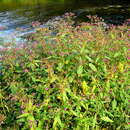Biology
(
Inglês
)
fornecido por Arkive
This annual plant germinates in February and March and grows rapidly. It flowers from June to October and produces a relatively high quantity of nectar (6). The flowers are mainly pollinated by bumblebees and wasps, and it has been shown that this introduced species competes with native plants for pollinators. As a result, native species set lower amounts of seed when growing in the vicinity of Himalayan balsam (7).
The generic part of the Latin name Impatiens means impatient, and refers to the means of dispersal of the seed, which is the key to the aggressive spread of this species (6). The seed capsule splits open explosively, scattering the seeds widely. Each plant can produce as many as 2,500 seeds (7), which can stay viable for 18 months and are spread widely in flowing water (6).
Although a popular plant with many, to conservationists Himalayan balsam is a very frustrating species to deal with. Its aggressive nature means that it frequently outcompetes native plants, and causes untold problems in sensitive habitats. Many local Wildlife Trusts organise 'balsam bashing' events to control the frequency of the plant in important sites (4).
Conservation
(
Inglês
)
fornecido por Arkive
Conservation action is not required for this common introduced species.
Description
(
Inglês
)
fornecido por Arkive
Himalayan or Indian balsam was introduced to British gardens from the Himalayas in 1839 and since then has become widely naturalised (4). This elegant plant is the tallest annual in Britain (3), growing up to 2 meters in height (2). The stems are reddish in colour and bear long, dark green lance-shaped leaves with toothed edges. The large brightly coloured flowers are variable shades of purplish-pink, and occasionally white (2). Their appearance has led to the alternative name of 'poor man's orchid'. Another charming local name, 'bee-bums' has arisen as it is just the back end of a bee that can be seen when it visits a flower of this plant (4).
Habitat
(
Inglês
)
fornecido por Arkive
Typically found in dense patches on the banks of rivers and other water bodies (3), as well as in wet woodlands, and on waste ground (2).
Range
(
Inglês
)
fornecido por Arkive
This introduced species had spread out of gardens and colonised British waterways by 1855 (5). It has since become widely naturalised and is now common in central England and Wales. It is not as numerous in Scotland and east England, but its range is still expanding (3) (2). In many areas, its spread has been aided by the deliberate scattering of seeds by fans of the plant (4). This species is native to the Himalayas, but has become naturalised throughout much of temperate Europe (3). It has also become established in parts of the USA (6).
Status
(
Inglês
)
fornecido por Arkive
Common and widespread. Not threatened (3).
Threats
(
Inglês
)
fornecido por Arkive
This species is not currently threatened.

